In recent years Mrs. Barn had been traveling to the West Coast several times a year to attend to her dad in his failing health. Normally she would not even carry any luggage beyond a small carry-on bag, so she left her laptop at home and just took her small Kindle. After making my prototype Kindle case last year I decided she needed a nice case to protect her smaller Kindle during her travels, so it was on my agenda for Christmas. I got it done just in time, but then we had to postpone our family Christmas for three months due to a variety of circumstances, not the least were my mother’s funeral, my father-in-law’s death and funeral, my son-in-law’s inadvertent exposure to someone with the ‘Rona, my daughter’s need for self-quarantining for work travel…
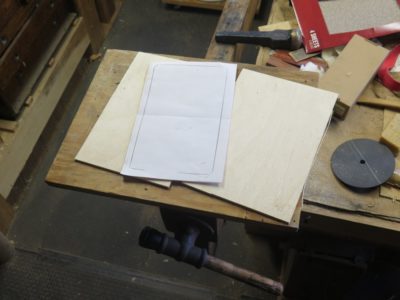
As with the first case I started by making my own veneer-core plywood using the abundant ash veneer from my stash using West System epoxy as the binder, under the dead weight of a stack of fire bricks. I am becoming even more smitten with this type of sheet good and may try to figure out how to make larger panels to employ in other projects. I have used Baltic birch plywood as my “go to” for years, and still rely on it a fair bit. But the veneer-core plywood is just something special. I guess I’m gong to have to make a large veneer press to make it happen.

Much of the goings-on in the shop are Christmas-gift related and therefore must wait a while before recounting them on this page. But one recent veneering exercise revealed the foibles implicit in being distracted by other activities, and what happens when you (by that I mean me) lose your concentration.
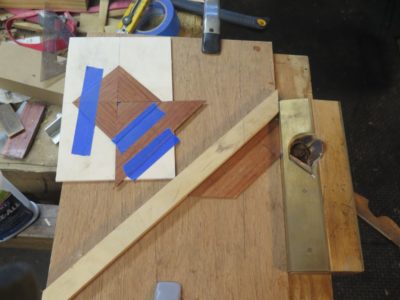
I was creating a fairly simple pattern from some rosewood veneer and everything went well and I managed to assemble the pattern with one little scrap I had to use.
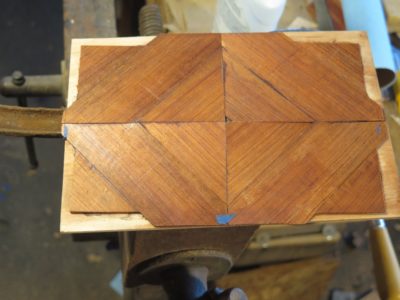
When I glued down the veneer to the substrate I simply forgot to anchor the composition into the correct place on the panel, and lined it up free then placed the caul and clamps. Of course the whole thing shifted under the weigh pressure and I saw the next day that everything was out of whack.
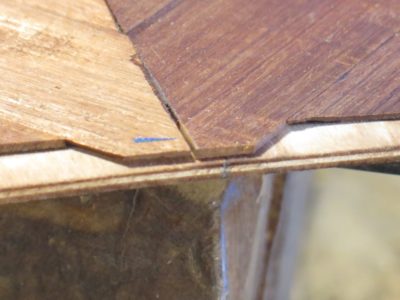
I tried to lift the veneer by soaking it with acetone, but it was too set for that to work. All I accomplished was tearing everything up. It was off and that was that. Now it’s off to the trash can.
Now my only question is, was this simple rookie mistake or a geezer mistake?.

In many instances, cutting dovetailed open mortises through a Roubo bench top for example, a 30-60-90 layout gauge only has to be “close enough,” however you define that term. All one layout line has to do is match another layout line, and as long the two lines are struck with the same tool off the same reference plane all is well.
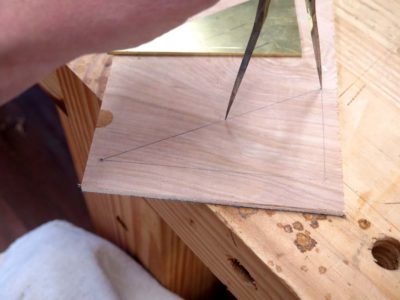
During last year’s workshop we all made one or two of these triangles, and like I said above, they work just fine. Laying out the hypotenuse with dividers was all that really needed to accomplish (the hypotenuse of a 30-60-90 triangle is exactly twice the length of the short leg), using my Chris Vesper sublime refence square for the 90-degree corner.
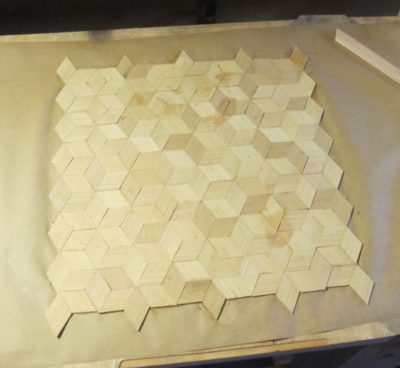
But what happens when you have to create a series of lines coming from different places, and they establish the perimeters of pieces that must match each other precisely? That is exactly the case of laying out a basic “starburst” or “dice” pattern parquetry composition. I used to be content with simply laying out a sawing jig using a small plastic triangle from a middle school geometry class set, but since I have moved to shooting the edges of all the lozenges to minimize the joints even more, I needed to make myself a truly precise triangle square to set the fence for the shooting board.
Starting with one of the brass triangles left over from the workshop two summer ago I determined to make a 30-60-90 square that fit the bill. Once I had the angles perfect I could then solder on the shoe to the short leg of the triangle.
Tomorrow I will show how I did just that with a bench top geometry version of a Covid/PCR test, using a piece of paper and two popsicle sticks.


With the two halves of the Kindle case ready, I glued on band of leather to bring the two of them together. The gluing was only to the faces of the case with the back edges unglued so that the case could be folded open with the two halves face-to-face.
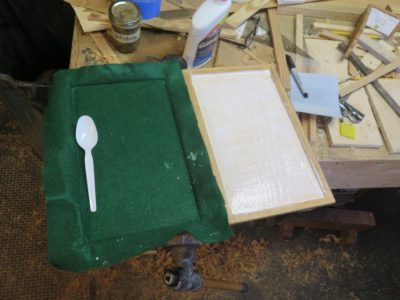

Once the two halves were put together I took some scrap felt from my rag bin and glued that into the cavity holding the Kindle. That was a nice effect, except for where I slipped with the razor blade while trimming the felt and cut off some of the cypress veneer. I hate when that happens, and will repair it when I get a chance.

With everything together and complete I spent a little time padding on some more shellac. I will probably repeat this periodically to build it up a bit more, but I wanted the case to get to work. I stuck on some velcro dots at the two corners to hold it together when not in use and called it “finished.”


A few days ago blog reader (and the Lou Gehrig of the woodworking blogosphere) RalphB asked about my use of the pumice block to smooth the surface of my parquetry Kindle case. The use of pumice blocks is well documented in historical accounts, although explicit or specific details are often missing.
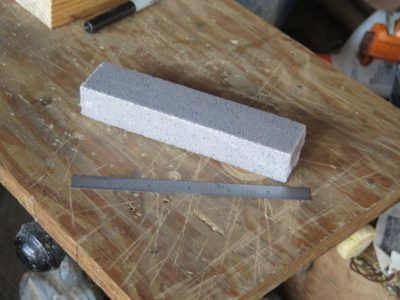
I use a pumice block from the plumbing section of the hardware store (I order them by the case). Normally they are used for deep cleaning of porcelain and enameled fixtures to remove mineral deposits and stains. They work equally well for evening out irregular wood surfaces such as those found when assembling parquetry or marquetry from sawn veneers, where regardless of the care in the initial veneer sawing a fair bit of irregularity is manifest.
I generally use a pumice block as the step following the toothing plane/Shinto rasp, moving the block in a circular fashion on the substrate, yielding a fairly smooth and even surface about what you might expect with 60 or 80 grit sandpaper. Following the pumice block with a card scraper and polissoir, the result is quite pleasing.
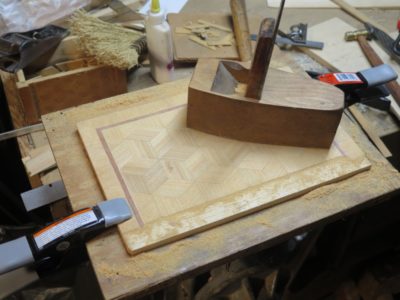

Once all the veneerwork was finished and the banding in place it was time to flatten all these irregular surfaces. Using a variety of tools, including a toothing plane and a Shinto rasp, I soon had things even enough to use a pumice block to smooth everything out.
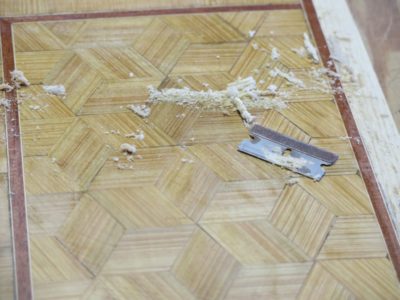
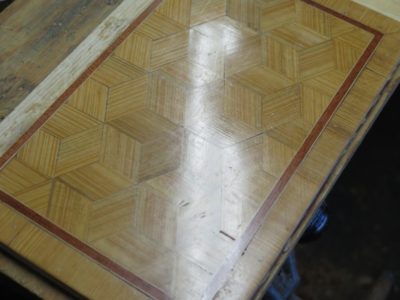
With my tacking iron I impregnated all the show surface with a generous application of molten Blend 31 wax to serve as a grain filler and foundation for a little bit of padded shellac yet to come. Using a fresh single edge razor I gently scraped off the excess wax to get down to the smooth surface, which was evident when I buffed the scraped surface with a piece of linen. Little places of voids were filled in with more molten wax after the buffing revealed them.

The two halves of the Kindle box are different because I was mostly trying to use leftovers from other projects.

In laying out the first of the parquetry patterns I was finding peace and solitude while listening to an audio book rather than news or similar podcasts. As always I laid out the patterns on kraft paper, gluing the pieces in place with a dab of stick adhesive. Once I had built the pattern beyond the boundaries of the field I flipped it over and glued it “face down,” this time with PVA since I needed an adverse-environment-resistant construction. Using a foam sheet between the paper and the plywood caul assured the pieces would conform intimately with the substrate. Their irregularities on the surface are irrelevant as the surface will be smoothed to a finished foundation.
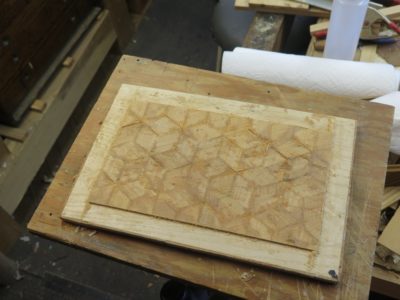

Using a straight edge and my Japanese mortise saw I trimmed the field to the designed size. I noted with interest the amount of curve that was introduced to the homemade epoxy/veneer plywood through the use of the water-based PVA emulsion to lay down the parquetry. Fortunately that cupping diminished in about 72 hours.

It was then time to saw the simple banding strips from a block I made long ago, fitting the corners with a 45-degree shooting board, then glued them in place along the perimeter of the field.

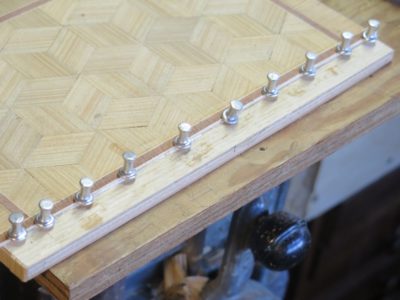
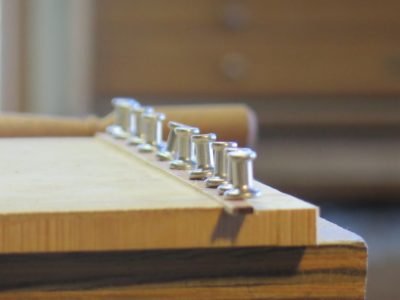
I have found the best method for holding the banding in place during the gluing is essentially the same as described by Roubo — wide head pins.
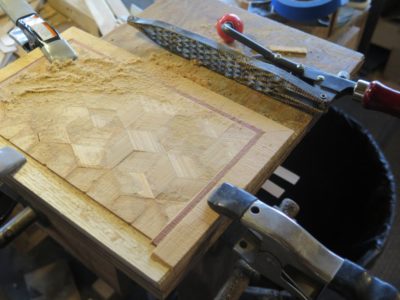
The next day I laid the edge decoration, which was just thin, cross-grained pieces of the sawn veneer. Once those were done I began the process of removing all the thickness variations and creating the perfect foundation for the finished surface.
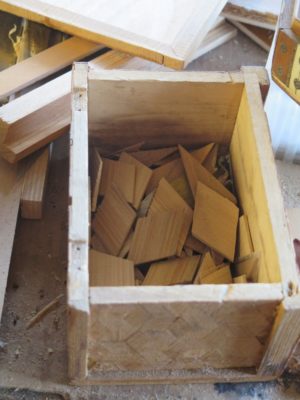
With the slim plywood “box” done for my new Kindle case it was time to move on to the tricked-out phase. That involved the assembly of a parquetry pattern from my inventory of 60-120-60 parallelogram lozenges.
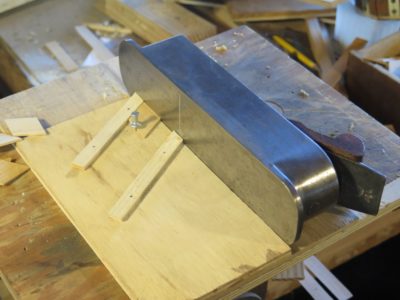

I knew right away that I did not have enough lozenges cut and trimmed to complete the job so I took some of the wood strips from my selection and sawed another bunch, enough to fill my little box to the top. I then shot the edges on my dedicated shooting board, fist shooting one pair of adjoined edges then rotating the lozenge onto the upper station, first planing one edge then flipping the lozenge and planing the adjacent one. I find this entire process of building up a stack of lozenges to be extremely calming, an especially respite in this current week. Plus, it let me put my sublime c.1810-50 Robert Towell miter plane to good use (fortunately for me Towell was careless about stamping his planes, otherwise I could not have afforded to buy this uber sewwt tool. Take note of the near-invisible opening in the sole!) I would have used the parquetry shooting plane I made last year but for the life of me I could not find where I put it. Sometimes having 7000 s.f. and several non-adjacent work spaces can be a curse, and this is one of those times.
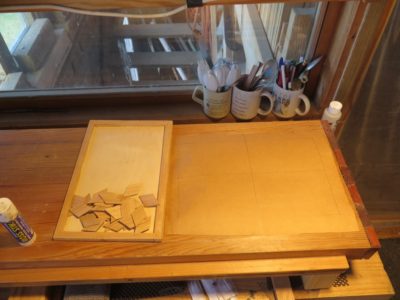

With enough of the finished lozenges in-hand I started setting them down on kraft paper after first drawing right angle bisecting lines to guide the work.

With a new Kindle in-hand, and wishing to protect it more attentively than the previous one, I’m making a case for it using the home-made epoxy/ash veneer plywood I described earlier. It will not be particularly fancy, just the <1/8″ plywood as the flat panels and the ~3/16″ plywood as the case walls. These will also serve as the ground for some nice French-style parquetry using up some of my re-existing lozenge and trim inventory. Not sure if “Pimp my Kindle” is a thing.

There is no “joinery” in the project, the case walls were just 1/2″ wide strips of the plywood glued to the 1/8″ panels around the template of the old dead Kindle.

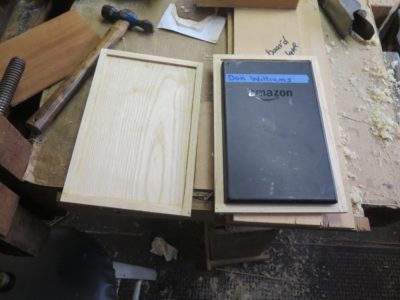

My excitement is building as the fancy work is now imminent.
Quoting the title of my least favorite song from probably my most favorite current band, I recently had a spectacular failure on something entirely mundane in the shop.
The locus of the action was my Kindle. I love having a Kindle, the ability to download and have a multitude of audio and textual books in-hand on a wisp of a tool is intoxicating. Plus, I can make the font size as large as I want, no small feature for someone with my eyesight. However, the Kindle is not a particularly robust tool and I fractured the screen soon after getting it. Nevertheless I continued using it without incident for a year until the design flaw in the re-charging port caused the unit to fail entirely and I replaced it. Mrs. Barn is on her second Kindle for exactly the same reason.
When my new Kindle arrived it was instantly apparent that the geniuses at Amazon recognized the re-charging port problem and upgraded the hardware considerably. Still, that would not really help me if I abused the unit physically to the point of breaking it. So, I decided to make a lightweight rigid case to house it. I had looked at a number of manufactured cases and even bought one but remained unsatisfied, hence my desire to make my own. I might have used some 5-ply 1/8″ aircraft plywood but unfortunately my inventory of this esoteric and very expensive material was inadequate for the project.

Instead I tried making my own, an undertaking I had engaged in numerous times. Over the years I have accumulated a sizeable pile of veneer sheets and this was a perfect time to consume a tiny bit of it.
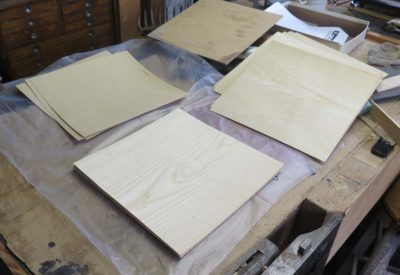
Cutting several pieces from the long veneer sheets, I glued up some 5- and 7-ply panels using some PVA adhesive.

I stacked the wet panels on top of each other with a sheet of food wrap between them, as I done done many times before. Since I do not have a veneer press I added flat cauls and a couple hundred pounds of firebricks on top and let it sit overnight.
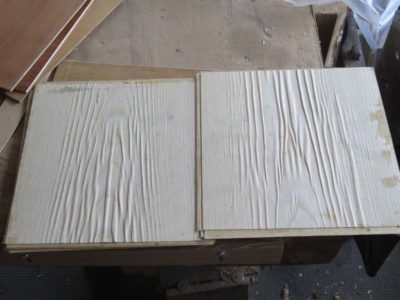

What I found the net morning on disassembling the set-up was not what I wanted, to say the very least. One of the plywood panels’ faces was perfectly flat, but the other was puckered beyond repair, or at least beyond any repair I wanted to spend my time on. Besides, I have a lot more veneer to play with.
Indeed, this was a spectacular failure.
Back to the drawing board. Stay tuned.














































Recent Comments